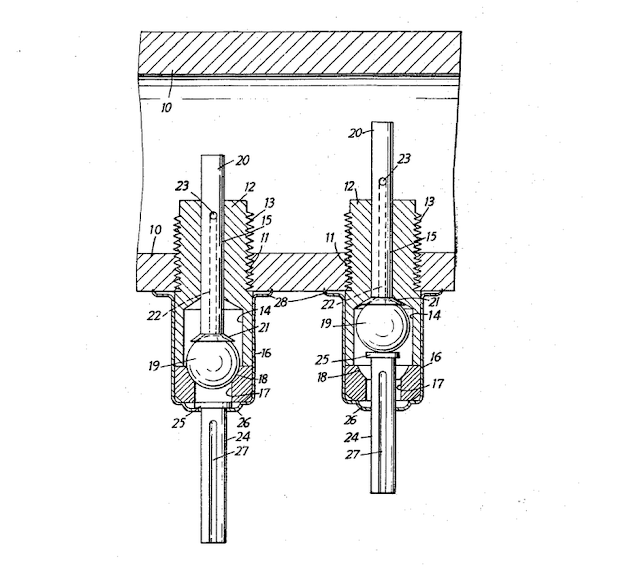How Poultry Nipples Work
Poultry nipples, sometimes called chicken nipples, are one-way valves that allows water to flow out, but don't allow air or other materials to flow in. As a result, the chickens water supply can't be contaminated by dirt and droppings.
Now compare the left hand diagram with that on the right that shows what happens when a chicken pecks at the lower stem to drink. The lower stem rises, pushing up the ball bearing and also the top stem. Water rushes down through channel #23 into the chamber and out through gap #17. The water is then dispensed directly into the chickens mouth.
When the chicken withdraws its beak, the mechanism goes into reverse; the lower stem falls, and the ball bearing and top stem also fall. This cuts off the flow of water.
Commercial Poultry Watering Systems & The Backyard Poultry Keeper
Poultry nipples are used extensively in the watering systems used by commercial poultry operations. However, these commercial watering systems were designed for owners with thousands, or tens of thousands of chickens. Commercial systems incorporate water pressure regulators, high pressure flushing valves, electrical anti-roosting devices and other components that are suitable for large scale poultry keeping, but too complicated, too expensive, and too large for backyard poultry keepers.
The BriteTap™ poultry nipple chicken waterer is designed for small-scale chicken keepers, but incorporates many of the benefits of large-scale commercial poultry watering systems. However, the BriteTap waterer does so at a fraction of the cost. The BriteTap waterer features the following:
Posting sponsored by ChickenWaterer.com, makers of the BriteTap automatic poultry waterer. The BriteTap waterer shields water from dirt and poop. The water stays clean and there are no messy pans for you to wash out.
Poultry nipples operate as follows:
- When a chicken pecks at a stem on the bottom of the poultry nipple, it rises up and causes a gap to form between an interior wall of the nipple and the stem.
- This allows water to flow around the stem and out through the bottom of the valve.
- When a chicken withdraws it's beak, the stem falls, closes the gap between the side wall of the poultry nipple and the stem, and shuts off the flow of water.
Although there are differences between various poultry nipple models, they all operate on this same basic principles. The below drawing is taken from a 1967 patent application and is typical of the type of poultry nipples that are produced to this day. The stem of the valve is labeled #27 in the drawing. The stem rests against a ball bearing #19 that sits in a rounded channel #18. When seated in the channel as shown on the left side of the diagram, the ball bearing creates a water tight seal. Above the ball bearing is a second stem #20 with a channel running down the interior #23. In the closed position the hole is covered so water from the pipe #10 can't enter into the valve.
 |
| Drawing from 1967 Poultry Nipple Patent Application by Kenneth Wilmot |
Now compare the left hand diagram with that on the right that shows what happens when a chicken pecks at the lower stem to drink. The lower stem rises, pushing up the ball bearing and also the top stem. Water rushes down through channel #23 into the chamber and out through gap #17. The water is then dispensed directly into the chickens mouth.
When the chicken withdraws its beak, the mechanism goes into reverse; the lower stem falls, and the ball bearing and top stem also fall. This cuts off the flow of water.
 |
| Leghorn Drinking from Poultry Nipples on the BriteTap Chicken Waterer |
Commercial Poultry Watering Systems & The Backyard Poultry Keeper
Poultry nipples are used extensively in the watering systems used by commercial poultry operations. However, these commercial watering systems were designed for owners with thousands, or tens of thousands of chickens. Commercial systems incorporate water pressure regulators, high pressure flushing valves, electrical anti-roosting devices and other components that are suitable for large scale poultry keeping, but too complicated, too expensive, and too large for backyard poultry keepers.
The BriteTap™ poultry nipple chicken waterer is designed for small-scale chicken keepers, but incorporates many of the benefits of large-scale commercial poultry watering systems. However, the BriteTap waterer does so at a fraction of the cost. The BriteTap waterer features the following:
- A closed-system design that includes poultry nipples. This design shields the chicken's water from dirt and droppings so it stays sanitary and owners don't need to clean the waterer on a daily basis.
- Clean-Out plugs on the ends of the waterer allow owners to clean the interior with a bottle brush. These clean out plugs are an inexpensive replacement for the high pressure flushing mechanisms used by commercial poultry watering equipment.
- Clear plastic construction so owners can see the interior of the waterer when cleaning it rather than relying on high-pressure flushing equipment required in large-scale systems.
- Anti-roosting is achieved by designing the BriteTap waterer so that the BriteTap waterer sits very close to the wall of the water supply tank. Chickens don't have space to roost on the BriteTap waterer so they can't soil it with their droppings. The design eliminates the need for mechanical or electrical anti-roosting devices.
- Easy set up and maintenance - The BriteTap can be mounted to any food-grade plastic container or to a standard water cooler. Set up takes just a few minutes and does not require special tools or rigging as is the case with commercial poultry watering systems.
For more information about the BriteTap waterer, visit http://www.ChickenWaterer.com
 |
| BriteTap Waterer Mounted to A Rubbermaid Water Cooler. Just unscrew the coolers spigot and replace with the BriteTap waterer |


Comments
Post a Comment